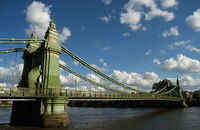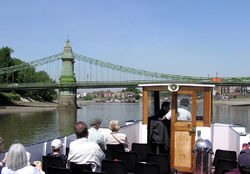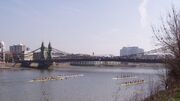| BRIDGE | ||
| Hammersmith Bridge | ||
|---|---|---|

| ||
| Carries | Motor vehicles | |
| Maintained by | ||
| Design | Suspension | |
| Total Length | 700 ft (213.4 m) | |
| Clearance Below | ||
| Opening Date | 1887 | |
Hammersmith Bridge is a crossing of the River Thames in west London, just south of the Hammersmith town centre area of the London Borough of Hammersmith and Fulham on the north side of the river. It allows road traffic and pedestrians to cross to Barnes (in the London Borough of Richmond upon Thames) on the south side of the river. The current bridge is the second permanent bridge on the site.
History[]
The construction of a bridge was first sanctioned by an Act of Parliament in 1824 and work on site began the following year. It was the Thames’ first suspension bridge and was designed by William Tierney Clark.
The bridge had a clear water-way of 688 feet 8 inches. Its suspension towers were 48 feet above the level of the roadway, where they were 22 feet thick. The roadway was slightly curved upwards, 16 feet above high water, and the extreme length from the back of the piers on shore was 822 feet 8 inches, supporting 688 feet of roadway. There were eight chains, composed of wrought-iron bars, each five inches deep and one thick. Four of these had six bars in each chain; and four had only three, making thirty-six bars, which form a dip in the centre of about 29 feet. From these, vertical rods were suspended, which supported the roadway, formed of strong timbers covered with granite. The width of the carriageway was 20 feet, with two footways of five feet. The chains passed over the suspension towers, and were secured to the piers on each shore. The suspension towers were of stone, and designed as archways of the Tuscan order. The approaches were provided with octagonal lodges, or toll-houses, with appropriate lamps and parapet walls, terminating with stone pillars, surmounted with ornamental caps. Construction of the bridge cost some £80,000. It was operated as a toll bridge.

Engraving of the first Hammersmith Bridge, made in 1827
By the 1870s Hammersmith Bridge was not strong enough to support the weight of heavy traffic and the owners were alarmed in 1870 when 11,000-12,000 people crowded onto the bridge to watch the University Boat Race, which passes under the bridge just before the halfway point of its 4 1/4 mile course. In 1884 a temporary bridge was put up to allow a more limited cross-river traffic while a replacement was constructed.
The current suspension bridge was designed by noted civil engineer Sir Joseph Bazalgette and rests on the same pier foundations constructed for Tierney Clark’s structure. The new bridge was built by Dixon, Appleby & Thorne. It was opened by the Prince of Wales on 11 June 1887.[1] With much of the supporting structure built of wrought iron, it is 700 feet (213.4 m) long and 43 feet (13.1 m) wide and cost £82,117 to build.
Structural soundness and repairs[]

Hammersmith Bridge, seen from the Westminster to Kew tourist boat

250px Rowing crews racing under Hammersmith Bridge
Hammersmith Bridge has long suffered structural problems and has been closed for lengthy periods on several occasions, due to the weight and volume of road traffic now common in inner London, which the bridge was not originally designed to support.
The bridge was refurbished in 1973 with replacement steel trusses, improvements to the mid-span hangers and new deck expansion joints. New deck timbers were installed and surfacing was changed from wooden blocks to coated plywood panels. These panels were subsequently replaced in 1987.
In 1984 the Barnes-side tower bearings failed under a heavy load and had to be replaced.
In February 1997 the bridge was closed to all traffic except buses, bicycles, motorcycles, emergency vehicles and pedestrians to allow further essential repair works. Structural elements of the bridge had been found to be corroded or worn, in particular cross girders and deck surfacing, as well as some areas of masonry.
The bridge re-opened in July 1998 to all road users, subject to a 7.5 ton weight restriction and with a priority measure in place for buses. Local bus flow was controlled by traffic lights, and routes (such as the 72) were required to convert from double-decker buses to smaller single-deckers to reduce the load on the bridge.
As part of the renovations following the 2000 IRA bombing (see below), the bridge received a complete new paint job restoring it to the original colour scheme of 1887, and new lighting was installed.
The bridge was declared a Grade II listed structure in 2008, providing protection to preserve its special character from unsympathetic development.
IRA attacks[]
At 4.30am on Thursday 1 June 2000 the bridge was damaged by a Real IRA bomb planted underneath the Barnes span. The blast came four years after a previous attempted bombing by the Provisional IRA, but following two years of closure for repairs the bridge was reopened with further weight restrictions in place.
The IRA's first attempt to destroy the 113-year-old bridge in 1939 had been foiled by a quick-thinking member of the public. Maurice Childs, a hairdresser from nearby Chiswick was walking home across the bridge in the early morning when he noticed smoke and sparks coming from a suitcase. He opened it to find a bomb. He threw the bag into the river and the resultant explosion sent up a 60ft column of water. Moments later, a second device exploded causing girders on the west side of the bridge to collapse and shattering windows in nearby houses.
Mr Childs was awarded an MBE for his courage.
Eddie Connell and William Browne were subsequently given jail sentences of 20 and 10 years respectively, for involvement in the bombing.
The Gov.UK page is here
| This page uses Creative Commons Licensed content from Wikipedia (view authors). That Wikipedia page probably contains more information. |